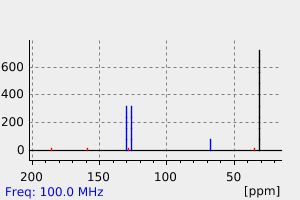2,2-二氯-1-[4-(1,1-二甲基乙基)苯基]乙烷-1-酮 | 50807-17-5
中文名称
2,2-二氯-1-[4-(1,1-二甲基乙基)苯基]乙烷-1-酮
中文别名
1H-吡唑-5-磺酸,3-乙酰基-1-甲基-
英文名称
1-(4-(tert-butyl)phenyl)-2,2-dichloroethan-1-one
英文别名
1-(4-(tert-butyl)phenyl)-2,2-dichloroethanone;2,2-Dichloro-1-(4-(1,1-dimethylethyl)phenyl)ethan-1-one;1-(4-tert-butylphenyl)-2,2-dichloroethanone
CAS
50807-17-5
化学式
C12H14Cl2O
mdl
——
分子量
245.149
InChiKey
VMCRQYHCDSXNLW-UHFFFAOYSA-N
BEILSTEIN
——
EINECS
——
-
物化性质
-
计算性质
-
ADMET
-
安全信息
-
SDS
-
制备方法与用途
-
上下游信息
-
文献信息
-
表征谱图
-
同类化合物
-
相关功能分类
-
相关结构分类
计算性质
-
辛醇/水分配系数(LogP):4.6
-
重原子数:15
-
可旋转键数:3
-
环数:1.0
-
sp3杂化的碳原子比例:0.42
-
拓扑面积:17.1
-
氢给体数:0
-
氢受体数:1
安全信息
-
海关编码:2914700090
SDS
上下游信息
-
上游原料
中文名称 英文名称 CAS号 化学式 分子量 P-叔丁基-2,2,2-三氯苯乙酮 1-[4-(tert-butyl)phenyl]-2,2,2-trichloroethan-1-one 51326-37-5 C12H13Cl3O 279.594 对叔丁基苯乙酮 4'-t-butylacetophenone 943-27-1 C12H16O 176.258
反应信息
-
作为反应物:描述:2,2-二氯-1-[4-(1,1-二甲基乙基)苯基]乙烷-1-酮 、 对硝基苯甲醛 在 sodium hydride 作用下, 以 四氢呋喃 、 mineral oil 为溶剂, 以74%的产率得到(4-(tert-butyl)phenyl)((2RS,3RS)-2-chloro-3-(4-nitrophenyl)oxiran-2-yl)methanone参考文献:名称:格利雅(Grignard)介导的2,2,2-三氯-1-芳酮的还原†摘要:可用RMgX将2,2,2-三氯-1-芳基-乙酮还原为相应的2,2-二氯-1-芳基-1-油酸酯,并用一系列亲电试剂捕集,导致还原,还原/羟醛,还原/ Claisen冷凝或还原/ Aldol-Tishchenko产品。此外,我们证明了2,2-二氯-1-芳基-1-油酸酯会经历抗衡离子控制的Darzens缩合反应,随后可以进行热重排,作为通往1,3-二芳基-3-氯丙烷-1的途径, 2-二酮。DOI:10.1039/c5ob00541h
-
作为产物:描述:4-叔-丁基苯基乙炔 在 盐酸 、 硫酸 、 lithium perchlorate 作用下, 以 水 、 乙腈 为溶剂, 反应 4.25h, 以83%的产率得到2,2-二氯-1-[4-(1,1-二甲基乙基)苯基]乙烷-1-酮参考文献:名称:末端炔烃衍生物电化学合成α,α-二卤代苯乙酮摘要:摘要利用电化学方法,可以容易地以良好或优异的收率获得一系列的α,α-二卤代苯乙酮。该电化学过程在含水介质中以恒定电流在分开的电池中进行。该反应可以在室温下在无金属和无氧化剂的条件下平稳进行,这为α,α-二卤代苯乙酮衍生物的生态合成提供了有利条件。DOI:10.1016/j.cclet.2020.02.030
文献信息
-
A Convenient and Efficient Synthesis of 1-Aryl-2,2-dichloroethanones作者:Alexander Terent’ev、Sergey Khodykin、Nikolay Troitskii、Yuri Ogibin、Gennady NikishinDOI:10.1055/s-2004-834871日期:——1-Arylethanones are readily chlorinated with an aqueous HCl-H2O2 system using ethanol as a cosolvent. The reaction proceeds rapidly and results in selective conversion of 1-arylethanones into 1-aryl-2,2-dichloroethanones in yields of 48-89%, depending on the nature of the substituent in the aryl group.
-
Iodine–DMSO-promoted divergent reactivities of arylacetylenes作者:Suhail A. Rather、Atul Kumar、Qazi Naveed AhmedDOI:10.1039/c9cc00346k日期:——generation of different structures. The reaction represents the first of its kind, involving the use of different iodine concentrations, temperatures, acids and salt to adjust the selectivity for the synthesis of different alkenes, α-functionalized ketones and α-ketomethylthioesters.
-
Electrochemical Oxidative Oxydihalogenation of Alkynes for the Synthesis of α,α-Dihaloketones作者:Xiangtai Meng、Yu Zhang、Jinyue Luo、Fei Wang、Xiaoji Cao、Shenlin HuangDOI:10.1021/acs.orglett.0c00052日期:2020.2.7An electrochemical oxydihalogenation of alkynes has been developed for the first time. Using this sustainable protocol, a variety of α,α-dihaloketones can be prepared with readily available CHCl3, CH2Cl2, ClCH2CH2Cl, and CH2Br2 as the halogen source under electrochemical conditions at room temperature.
-
ASYMMETRIC ORGANIC PEROXIDE, CROSSLINKING AGENT COMPRISING THE SAME, AND METHOD OF CROSSLINKING WITH THE SAME申请人:NOF CORPORATION公开号:EP1233014A1公开(公告)日:2002-08-21A crosslinking agent comprising an asymmetry organic peroxide having at least one structure unit of (substituted)benzoylcarbonyloxy group represented by the following formula (1) in the molecule thereof. Environmentally friendly crosslinking agents and crosslinked silicone rubber moldings are provided thereby. Specifically, useful crosslinking agents and crosslinking processes for silicone rubber are provided.
-
Modular and Chemoselective Strategy for Accessing (Distinct) α,α‐Dihaloketones from Weinreb Amides and Dihalomethyllithiums作者:Saad Touqeer、Raffaele Senatore、Monika Malik、Ernst Urban、Vittorio PaceDOI:10.1002/adsc.202001106日期:2020.11.18The selective transfer of diversely functionalized dihalomethyllithiums (LiCHBrCl, LiCHClI, LiCHBrI, LiCHCl2, LiCHBr2, LiCHFI) to Weinreb amides for preparing gem‐dihaloketones in one synthetic operation is reported. The capability of these amides as acylating agents and, the wide availability of dihalomethanes as pronucleophiles, enable a straightforward route to the title compounds under full chemocontrol
表征谱图
-
氢谱1HNMR
-
质谱MS
-
碳谱13CNMR
-
红外IR
-
拉曼Raman
-
峰位数据
-
峰位匹配
-
表征信息
同类化合物
(反式)-4-壬烯醛
(s)-2,3-二羟基丙酸甲酯
([1-(甲氧基甲基)-1H-1,2,4-三唑-5-基](苯基)甲酮)
(Z)-4-辛烯醛
(S)-氨基甲酸酯β-D-O-葡糖醛酸
(S)-3-(((2,2-二氟-1-羟基-7-(甲基磺酰基)-2,3-二氢-1H-茚满-4-基)氧基)-5-氟苄腈
(R)-氨基甲酸酯β-D-O-葡糖醛酸
(5,5-二甲基-2-(哌啶-2-基)环己烷-1,3-二酮)
(2,5-二氟苯基)-4-哌啶基-甲酮
龙胆苦苷
龙胆二糖甲乙酮氰醇(P)
龙胆二糖丙酮氰醇(P)
龙胆三糖
龙涎酮
齐罗硅酮
齐留通beta-D-葡糖苷酸
鼠李糖
黑芥子苷单钾盐
黑海棉酸钠盐
黑木金合欢素
黑曲霉三糖
黑介子苷
黄尿酸8-O-葡糖苷
麻西那霉素II
麦迪霉素
麦芽糖脎
麦芽糖基海藻糖
麦芽糖1-磷酸酯
麦芽糖
麦芽四糖醇
麦芽四糖
麦芽十糖
麦芽六糖
麦芽五糖水合物
麦芽五糖
麦芽五糖
麦芽五糖
麦芽三糖醇
麦芽三糖
麦芽三糖
麦芽三塘水合
麦芽七糖水合物
麦芽七糖
麦法朵
麦可酚酸-酰基-Β-D-葡糖苷酸
麦利查咪
麝香酮
鹤草酚
鸢尾酚酮 3-C-beta-D-吡喃葡萄糖苷
鸡矢藤苷







